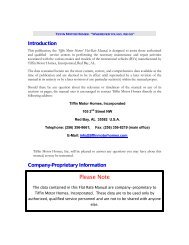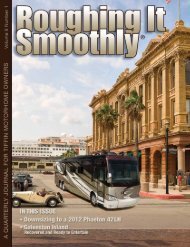Vol. 4 # 4 - Tiffin Motorhomes
Vol. 4 # 4 - Tiffin Motorhomes
Vol. 4 # 4 - Tiffin Motorhomes
- No tags were found...
Create successful ePaper yourself
Turn your PDF publications into a flip-book with our unique Google optimized e-Paper software.
University. The memorial was dedicated November 13, 1982.In January 1982 Washington sculptor Frederick Hart wasselected to create a figurative sculpture of three fighting men.Hart’s goal was “to create a moving evocation of the experienceand service of the Vietnam veteran.” The life-sized sculpturetook its place in the trees across the lawn from the memorialwall. Just a few steps away, also as a part of the Vietnam VeteransMemorial, the Vietnam Women’s Memorial honors the womenof the U.S. Armed Forces who served in the war. Sculpted byGlenna Goodacre, the statue presents three women taking careof a fallen soldier. Planted around the memorial are eight yellowwoodtrees—a living tribute to the eight service women whowere killed in action in the Vietnam War. A memorial plaquehonors the personal sacrifice made during an unfortunatelycontroversial war:In honor of the men and women of the armed forces of the UnitedStates who served in the Vietnam War. The names of those whogave their lives and of those who remain missing are inscribed inthe order they were taken from us.The Vietnam Veterans Memorial Fund, Inc., was the idea ofJan Scruggs, a former infantry corporal who served in the war.The non-profit charitable organization wanted Vietnam veteransto have a tangible symbol of recognition from a broadsection of American society.The World War II Memorial, dedicated on May 29, 2004, is thecountry’s most recent commemoration to its military. Situatedon the great mall between the Washington Monument and theLincoln Memorial, it reflects the importance of World War II inpreserving and internationalizing democratic ideals won underGeorge Washington and defended under Abraham Lincoln. Theinscription in the primary monument will grip your heart:Here in the presence of Washington and Lincoln, one the 18th centuryfather and the other the 19th century preserver of our nation,we honor those 20th century Americans who took up the struggleduring the second world war and made the sacrifices to perpetuatethe gift our forefathers entrusted to us: a nation conceived inliberty and justice.Certainly the largest of all of Washington’s war memorials,the expansive granite structure is anchored on its northern andsouthern perimeters by twin 43-foot Atlantic and Pacific pavilionsto symbolize a war fought across two oceans. Flanked by56 pillars (14 on either side of each pavilion) representing the48 states in the union at the time of the war, plus eight dependencies,the memorial opens on 17th Street facing the WashingtonMonument. The entrance is bordered with 12 bas-reliefsculptures depicting scenes of America at war. In one scene,a family gathers around its radio to hear President Rooseveltask Congress for a declaration of war after Japan bombed PearlHarbor. On the western side of the elliptical pool, the FreedomWall faces the Lincoln Memorial which frames a blue field containing4,048 gold stars, each representing approximately 100American deaths incurred during the war. Wreaths of oak andwheat on each of the memorial’s pillars symbolize the nation’sagricultural and industrial strength, both essential to the successof the war effort.The floor of each pavilion is inscribed with “Victory on Land,Victory at Sea, Victory in the Air, 1941–1945” encircling a brassinlaid Victory Medal. Each serviceman received a Victory Medalat the end of the war.The plaza occupies an area the size of a football field, is sunksix feet below grade, and contains a 247-foot elliptical pool withfountains. It appropriately honors the “greatest generation” andreminds future generations that we must sometimes sacrifice forcauses greater than ourselves. World War II changed the world asit was “fought across six of the world’s seven continents and all ofits oceans,” wrote British historian John Keegan. “It killed 50 millionhuman beings, left hundreds of millions of others woundedin mind and body . . . and devastated vast sections of the earth.”Other memorials in the Washington area honoring individualbranches of the military include the U.S. Navy Memorial andthe Naval Heritage Center at 701 Pennsylvania Ave., NW. In additionto the impressive granite plaza featuring a map of the entireglobe, flag displays and the statue of “The Lone Sailor” with hisduffel bag grace the area. Occasional concerts by the U.S. NavyBand (during the summer months) are usually scheduled at dusk.On the northeast corner, The Naval Heritage Center presents ahost of interesting displays about the Navy’s role in defending ournation. If you are a current or former Navy serviceman, be sure tovisit The Navy Log. Bring a picture of yourself in uniform alongwith your dates of service and other pertinent information. Beinga part of the registry is free and may help you link up with an oldbuddy. Other features of the Heritage Center include the Ship’sStore (gifts for sailors past or present), the Burke Theater (moviesabout the U.S. Navy), the President’s Room (U.S. presidents whoserved in the Navy), the Media Resource Room (historical videos,photos, and reference material), the Commemorative PlaqueWall (honoring our ships, sailors, and supporters), and severaldisplays in the Historical Exhibits area.The U.S. Marine Corps Memorial just across the Potomacin Arlington is probably the most dramatic of all the militarymemorials because it freezes the action of six soldiers raisingthe American flag on Mt. Suribachi during the battle to removethe Japanese forces from Iwo Jima. That flag, flying from thehighest point on the island, was raised after four days of intensefighting, although the battle continued for 36 days. One-thirdof all Marine losses during World War II happened at Iwo Jima.It was the only large engagement of the war in which Alliedforces suffered more casualties (dead plus wounded) than theirJapanese counterparts.The Japanese were using Iwo Jima to intercept our long-rangeB-29 bombers attacking the Home Islands. Capturing the islandwould cut in half the distance the bombers would have to fly.Many thought the island would be used as a staging site forthe inevitable invasion of Japan. The Allied command expectedthe battle to be over in two days, but the Japanese were holedup in hundreds of caves and prepared to fight to the death. Ofthe 110,000 U.S. forces involved in the attack, the Marines had5,598 killed, 19,197 wounded, and 494 missing. Of the estimated22,000 Japanese defenders, 20,703 were killed and 216 captured.Clockwise from left: One of the two Vietnam Memorial’s polishedgranite walls mirrors the visitors who come to find a loved one’s namehonored for his sacrifice. •The World War II Memorial is divided intotwo theaters. Pictured here is the Atlantic theater flanked by 14 granitepillars on each side, representing half of the 48 states and the U.S.dependencies who sent troops into battle. The Pacific theater is on thesouthern side of the memorial. •Five Marines and a Navy corpsmanraised the American flag on the top of Mt. Suribachi, where it couldbe seen by all of the American troops fighting throughout the island.•“The Lone Sailor” immortalized in bronze reminds us of the thousandsof sailors traveling with their duffel bags to their duty stations.20 Roughing It SmoothlyWashington 21
















